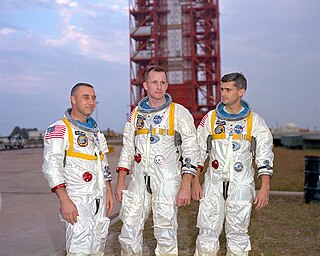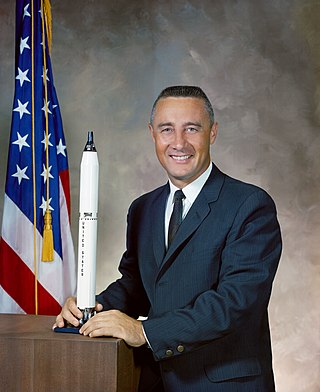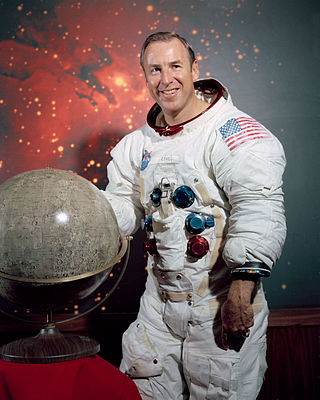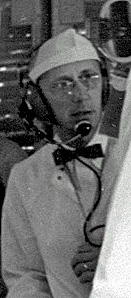
The Apollo program, also known as Project Apollo, was the United States human spaceflight program carried out by the National Aeronautics and Space Administration (NASA), which succeeded in preparing and landing the first men on the Moon from 1968 to 1972. It was first conceived in 1960 during President Dwight D. Eisenhower's administration as a three-person spacecraft to follow the one-person Project Mercury, which put the first Americans in space. Apollo was later dedicated to President John F. Kennedy's national goal for the 1960s of "landing a man on the Moon and returning him safely to the Earth" in an address to Congress on May 25, 1961. It was the third US human spaceflight program to fly, preceded by the two-person Project Gemini conceived in 1961 to extend spaceflight capability in support of Apollo.

Apollo 7 was the first crewed flight in NASA's Apollo program, and saw the resumption of human spaceflight by the agency after the fire that had killed the three Apollo 1 astronauts during a launch rehearsal test on January 27, 1967. The Apollo 7 crew was commanded by Walter M. Schirra, with command module pilot Donn F. Eisele and lunar module pilot R. Walter Cunningham.

Apollo 1, initially designated AS-204, was planned to be the first crewed mission of the Apollo program, the American undertaking to land the first man on the Moon. It was planned to launch on February 21, 1967, as the first low Earth orbital test of the Apollo command and service module. The mission never flew; a cabin fire during a launch rehearsal test at Cape Kennedy Air Force Station Launch Complex 34 on January 27 killed all three crew members—Command Pilot Gus Grissom, Senior Pilot Ed White, and Pilot Roger B. Chaffee—and destroyed the command module (CM). The name Apollo 1, chosen by the crew, was made official by NASA in their honor after the fire.

Human spaceflight is spaceflight with a crew or passengers aboard a spacecraft, often with the spacecraft being operated directly by the onboard human crew. Spacecraft can also be remotely operated from ground stations on Earth, or autonomously, without any direct human involvement. People trained for spaceflight are called astronauts, cosmonauts (Russian), or taikonauts (Chinese); and non-professionals are referred to as spaceflight participants or spacefarers.

Project Mercury was the first human spaceflight program of the United States, running from 1958 through 1963. An early highlight of the Space Race, its goal was to put a man into Earth orbit and return him safely, ideally before the Soviet Union. Taken over from the US Air Force by the newly created civilian space agency NASA, it conducted 20 uncrewed developmental flights, and six successful flights by astronauts. The program, which took its name from Roman mythology, cost $2.57 billion. The astronauts were collectively known as the "Mercury Seven", and each spacecraft was given a name ending with a "7" by its pilot.

Neil Alden Armstrong was an American astronaut and aeronautical engineer who in 1969 became the first person to walk on the Moon. He was also a naval aviator, test pilot, and university professor.

Virgil Ivan "Gus" Grissom was an American engineer and pilot in the United States Air Force, as well as one of the original seven men, the Mercury Seven, selected by the National Aeronautics and Space Administration for Project Mercury, a program to train and launch astronauts into outer space. Grissom was also a Project Gemini and Apollo program astronaut for NASA. As a member of the NASA Astronaut Corps, Grissom was the second American to fly in space in 1961. He was also the second American to fly in space twice, preceded only by Joe Walker with his sub-orbital X-15 flights.

Elliot McKay See Jr. was an American engineer, naval aviator, test pilot and NASA astronaut.

Gemini 3 was the first crewed mission in NASA's Project Gemini and was the first time two American astronauts flew together into space. On March 23, 1965, astronauts Gus Grissom and John Young flew three low Earth orbits in their spacecraft, which they nicknamed Molly Brown. It was the first U.S. mission in which the crew fired thrusters to change the size and shape of their orbit, a key test of spacecraft maneuverability vital for planned flights to the Moon. It was also the final crewed flight controlled from Cape Kennedy Air Force Station in Florida, before mission control functions were moved to a new control center at the newly opened Manned Spacecraft Center in Houston, Texas.

John Watts Young was an American astronaut, naval officer and aviator, test pilot, and aeronautical engineer. He became the 9th person to walk on the Moon as commander of the Apollo 16 mission in 1972. He is the only astronaut to fly on four different classes of spacecraft: Gemini, the Apollo command and service module, the Apollo Lunar Module and the Space Shuttle.

Walter Marty Schirra Jr. was an American naval aviator, test pilot, and NASA astronaut. In 1959, he became one of the original seven astronauts chosen for Project Mercury, which was the United States' first effort to put humans into space. On October 3, 1962, he flew the six-orbit, nine-hour, Mercury-Atlas 8 mission, in a spacecraft he nicknamed Sigma 7, becoming the fifth American and ninth human to travel into space. In December 1965, as part of the two-man Gemini program, he achieved the first space rendezvous, station-keeping his Gemini 6A spacecraft within 1 foot (30 cm) of the sister Gemini 7 spacecraft. In October 1968, he commanded Apollo 7, an 11-day low Earth orbit shakedown test of the three-man Apollo Command/Service Module and the first crewed launch for the Apollo program.

James Arthur Lovell Jr. is an American retired astronaut, naval aviator, test pilot and mechanical engineer. In 1968, as command module pilot of Apollo 8, he became, with Frank Borman and William Anders, one of the first three astronauts to fly to and orbit the Moon. He then commanded the Apollo 13 lunar mission in 1970 which, after a critical failure en route, looped round the Moon and returned safely to Earth.

The Mercury Seven were the group of seven astronauts selected to fly spacecraft for Project Mercury. They are also referred to as the Original Seven and Astronaut Group 1. Their names were publicly announced by NASA on April 9, 1959; these seven original American astronauts were Scott Carpenter, Gordon Cooper, John Glenn, Gus Grissom, Wally Schirra, Alan Shepard, and Deke Slayton. The Mercury Seven created a new profession in the United States, and established the image of the American astronaut for decades to come.

Project Gemini was the second United States human spaceflight program to fly. Conducted after the first, Project Mercury, and while the Apollo program was still in development, Gemini was conceived in 1961 and concluded in 1966. The Gemini spacecraft carried a two-astronaut crew. Ten Gemini crews and 16 individual astronauts flew low Earth orbit (LEO) missions during 1965 and 1966.

NASA Astronaut Group 2, also known as the Next Nine and the New Nine, was the second group of astronauts selected by the National Aeronautics and Space Administration (NASA). Their selection was announced on September 17, 1962. The group augmented the Mercury Seven. President John F. Kennedy had announced Project Apollo, on May 25, 1961, with the ambitious goal of putting a man on the Moon by the end of the decade, and more astronauts were required to fly the two-man Gemini spacecraft and three-man Apollo spacecraft then under development. The Mercury Seven had been selected to accomplish the simpler task of orbital flight, but the new challenges of space rendezvous and lunar landing led to the selection of candidates with advanced engineering degrees as well as test pilot experience.

Günter F. Wendt was a German-born American mechanical engineer noted for his work in the U.S. human spaceflight program. An employee of McDonnell Aircraft and later North American Aviation, he was in charge of the spacecraft close-out crews at the launch pads for the entire Mercury and Gemini programs (1961–1966) and the crewed phases of the Apollo, Skylab, and Apollo–Soyuz programs (1968–1975) at the Kennedy Space Center (KSC). His official title was Pad Leader.

The United States Astronaut Hall of Fame, located inside the Kennedy Space Center Visitor Complex Heroes & Legends building on Merritt Island, Florida, honors American astronauts and features the world's largest collection of their personal memorabilia, focusing on those astronauts who have been inducted into the Hall. Exhibits include Wally Schirra's Sigma 7 space capsule from the fifth crewed Mercury mission and the Gemini IX spacecraft flown by Gene Cernan and Thomas P. Stafford in 1966.































